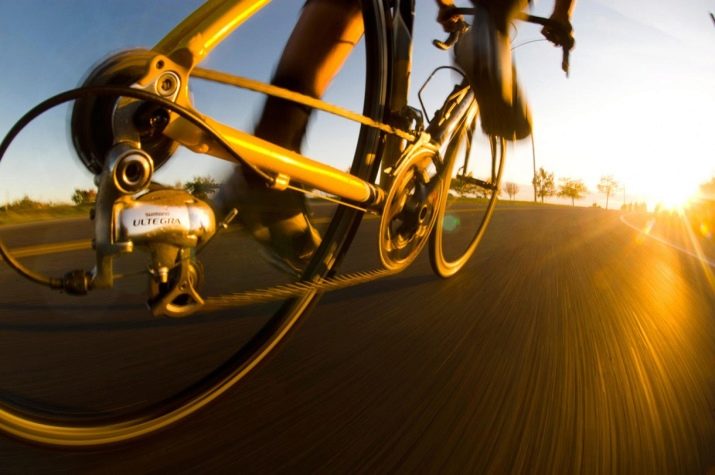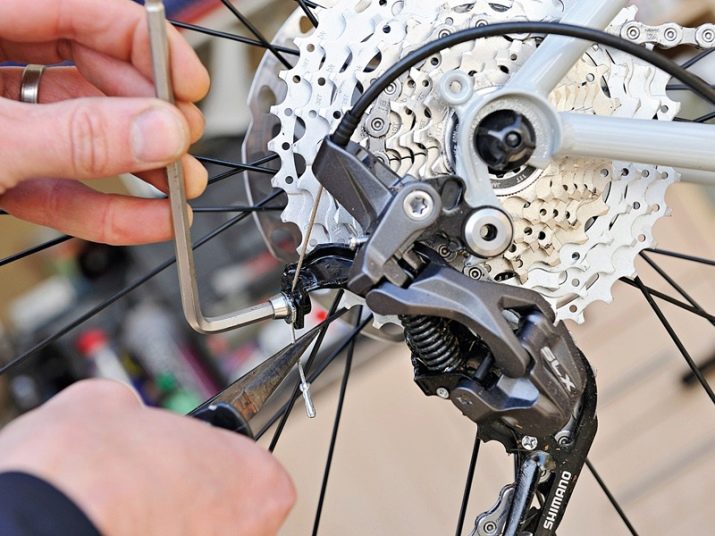Bicycle speed: what happens and what affects it?

Every person who starts cycling is interested in how fast you can accelerate, and what affects its performance. To understand this issue, you should familiarize yourself with the main factors that affect the pace of the ride, and methods that help to increase it.
What does it depend on?
Cycling is a very rewarding activity, which is difficult to disagree with. And also this type of transport is able to give the feeling of flight from movement, which attracts the attention of many people. More and more novice cyclists are wondering what affects the speed of movement, since it is this indicator that determines the number of positive emotions associated with driving around the city and countryside.

Cyclist training level
Bicycle speed indicators depend primarily on the endurance and physical characteristics of the cyclist himself. Experience will affect speed performance more than the type of vehicle chosen. For example, if an experienced rider is riding on a highway, he will be able to outrun an amateur on a mountain bike on a mountain bike. He will not only leave his rivals in the tail, but will also maintain high speed performance during the climb.

Oncoming air resistance
When driving at a speed of 25 km / h, the resistance of the air masses begins to slow down the ride. With a headwind, difficulty arises already at a speed of 10 km / h. If you are using a mountain bike with a wide, high-set handlebar, along with a low-rise saddle, pedaling becomes difficult at 30 km / h. On a road bike, this process will be easier because the handlebars are narrow and have a low grip.
If there is a noticeable oncoming air flow, the cyclist on the road bike can bend over to the handlebars, which will reduce the load.

Rolling resistance
This resistance will be well felt at the very beginning of the movement. The cyclist spends a lot more energy to take off from the spot when compared with normal movement. After the bike has already started, the rolling resistance does not affect the energy consumption with such force, which is required during acceleration. This indicator decreases as the speed picks up.

Friction
The increase in friction that occurs between the tires and the road surface begins to increase the degree of rolling resistance. Narrow tires that push through soft ground are difficult to lift off the surface. Wheels with wide tread, on the other hand, rub too hard on the asphalt and wear out quickly.
For this reason, it is recommended to select wheels according to such indicators as width, area and tread depth. The indicators must correspond to the road surface on which the trips are planned.

Chamber pressure
This metric also has an impact on speed because it affects the friction that occurs between the tires and the roadway. The more atmospheres a wheel has, the easier it is to roll on a hard surface. To make it easier to drive off-road, it is best to lower the pressure in the chambers.

The weight
The weight parameters of a 2-wheeled vehicle also affect the speed, since a large mass will increase rolling resistance. It is much easier to climb a mountain with a road vehicle than to push up a heavy mountain bike.

Bike condition
Reduces speed, even if the control is carried out thanks to the efforts of the athlete, with an unlubricated chain in the bicycle. Worn rubber bands will also reduce speed performance.
If a fast and safe ride is planned, it is recommended to replace the worn bushings and carriage, and regularly check the condition of the chain.
Soft shock absorbers reduce speed on smooth asphalt surfaces. However, soft shock absorbers are fine for uneven terrain.

Average bike speeds
Previously, bicycles were equipped with rather oversized mechanical speedometers, which could not boast of reliability in measuring the speed limit. At the moment, they have been replaced by compact electronic devices that accurately measure speed. With their help, you can not only find out at what speed the bike is currently moving, but also fix the average speed per hour, the duration of the section, the cost of calories and even the rider's heart rate.
Beginners, seeing a speed of 25-30 km / h on the speedometer, may decide that this is the average speed at which their bike travels throughout the entire time.
This opinion is erroneous, since only an experienced person is able to move at such a pace, and a simple rider in most cases moves at an average speed of 15-20 km / h.

And also the model of the used two-wheeled vehicle will influence the speed indicators. For example, in a straight line with an asphalt surface, the average speed of a road bike will be 20-25 km / h. The 10 km section will be covered in 25 minutes. The pace of the mountain will be about 18-20 km / h. You can put an electric motor to increase this indicator. In an urban environment, cycling will require stopping at intersections, maneuvering between cars and making way for pedestrians. That's why the average speed of even a sports bike will be 5-10 km lower when compared with the indicator with which vehicles travel on the highway.

How to increase?
Every cyclist asks the question of how you can increase your cycling speed. There are several tricks with which you can increase your performance, become more resilient and experienced.
Correct fit
Since the wind is the main obstacle to building up the pace, you should be able to properly sit on your bike. To get in the right position the cyclist should bend at the lower back and pull the body against the handlebars. It is recommended to press your elbows to the body. With this technique, you can immediately see how the average speed is getting higher.

Riding in a group
Some people think that this method is not entirely fair when it comes to increasing the average speed. However, while riding in a group, less resources will be spent on fighting the resistance of air masses.
The cyclist will be able to focus on a more experienced partner, try to match him, thereby increasing his riding skills.

Inflating the wheels
A well-inflated wheel will roll faster - this is a proven fact. It is recommended to check the tire pressure before each ride. You need to inflate to the value indicated on the sidewall of the tire. To make the pumping process more comfortable, it is best to purchase a high-quality floor-type pump.

Braking minimum
This rule is the simplest one. After braking, it will take a lot of effort to accelerate to the previous pace. That's why you should get rid of unnecessary pressing on the brake. First of all you need to stop slowing down, when the bike is rolling downhill. If the road surface is level and there are no cars nearby, this action is not required. In the future, you can learn to take turns at speed.

Track stand
On the roads, cyclists always attract attention, who, when stopping at traffic lights, do not get off their two-wheeled friend, but balance on it. This trick serves not only to attract glances, but also has a practical function: if you stop the pedals, then in 3 revolutions you can pick up a decent speed.

Direction of the wind
When planning a route taking into account the direction of the wind, you can maintain a good speed and not get tired much while fighting the headwind.
It is recommended to go upwind at the beginning of training, as the power reserve will allow you to fight the air masses, and it is best to return home with a tailwind.

Weight loss
To speed up, you need to work on yourself, getting rid of a few extra pounds. The effect will be noticeable immediately on the rise, and the frontal silhouette will become smaller, which indicates a decrease in air resistance.

Interval
Interval training can help improve your average speed. For this, two minutes of intensive driving in several passes are enough. Can be practiced during commuting 3-4 times in one trip.

Work with muscles
Resistance exercise builds muscle, which will also affect your cycling pace. It is recommended not to throw your body in the off-season and go to the gym during the winter.

Improving the bike
The purchase of a lightweight frame and high-profile wheels will help to increase speed performance. Such a purchase will help to reduce air resistance and increase the pace of the ride.

The right clothes
A form-fitting bike is the best option for riding. Not only is it able to wick heat and sweat away from the body, but it also reduces resistance to air masses, unlike loose clothing.

Records
Every cyclist interested in increasing speed should know what the maximum performance has been set for the sport.The absolute record of speed indicators in races was recorded in 1995. The indicator is 268.8 km / h. The achievement belongs to the Dutch cyclist Fred Rompelberg. It is important to know that the athlete turned 50 that year. The ride itself was carried out in the United States, in the state of Utah. The race took place on a very flat surface next to a salt lake, on the Bonneville Plain.
Fred's bike was prepared for the race and modified: they installed a special transmission system on the rear sprocket and greatly increased the gear ratio.
A car was driving in front of the bicycle, which contributed to the formation of a section of reduced pressure. The record for descending from the mountain was recorded on ice cover and dirt.

In the winter season, the leading position was taken by Eric Baron.
On the territory of the Alps, he managed to accelerate his bike to a speed of 222 km / h.
The record was recorded on April 12, 2000. In 2002, this athlete took third place on the Sierro Negro mountain, going down the gravel. The ride for the cyclist was terrible: at the finish line he accelerated to 210.4 km / h, but his two-wheeled vehicle was literally torn to pieces. The tragedy was avoided only thanks to the good protective ammunition and the preparedness of the athlete.

In the next video, you can watch the movement of a cyclist at a speed of 150 km / h.








